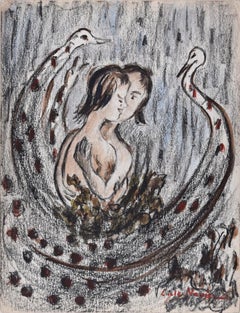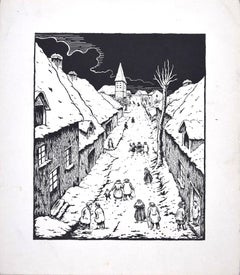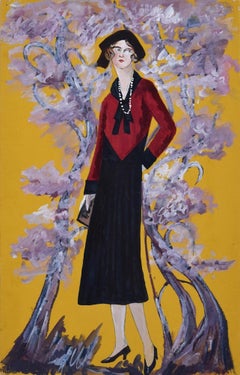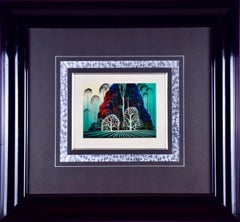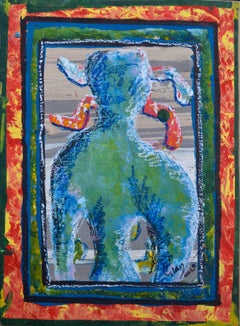Lucie Navier Art
to
3
8
5
3
8
Overall Height
to
Overall Width
to
5
6
4
4
2
2
1
1
1
1
1
1
1
1
1
1
1
8
1
7
8
6,996
3,348
2,513
1,213
7
5
2
2
2
Artist: Lucie Navier
Poseidon - Ink and Tempera on Paper by Lucie Navier - 1933
By Lucie Navier
Located in Roma, IT
Poseidon is an original painting realized by Lucie Navier in 1933.
Original Ink and tempera painting on paper.
Dated on the lower right corner (23-6-2033).
Fair conditions except...
Category
1930s Modern Lucie Navier Art
Materials
Tempera, Watercolor, Ink
Marine - Tempera on Paper by Lucie Navier - 1927
By Lucie Navier
Located in Roma, IT
Marine is a painting realized by Lucie Navier in the 1927.
Tempera on paper.
Mint conditions.
Impressionistic work realized with a Realistic technique and representing a natural...
Category
1920s Modern Lucie Navier Art
Materials
Tempera
Peacocks - Original Mixed Media on Paper by Lucie Navier - 1930s
By Lucie Navier
Located in Roma, IT
Peacocks is a painting realized by Lucie Navier in the 1930s.
Original tempera painting and pastels on cardboard.
Hand-signed by the artist on the lower right corner in red paintin...
Category
1930s Modern Lucie Navier Art
Materials
Tempera, Pastel
Nocturnal Village - Original Screen Print by Lucie Navier
By Lucie Navier
Located in Roma, IT
Nocturnal Village is an original artwork realized by the French artist Lucie Navier (1910-1996) in the 1930s.
Original black and white serigraph...
Category
1930s Modern Lucie Navier Art
Materials
Screen
Madame in the Blossom Garden - Tempera on Paper by Lucie Navier - 1931
By Lucie Navier
Located in Roma, IT
Madame in the blossom garden is an original painting realized by Lucie Navier in the 1931.
Original tempera on paper.
Very good conditions.
Colorful composition representing a f...
Category
1930s Modern Lucie Navier Art
Materials
Tempera
Muslim - Original Mixed Media on Paper by Lucie Navier - 1930s
By Lucie Navier
Located in Roma, IT
Muslim is an original painting realized by Lucie Navier.
Original tempera painting on paper. The sheet is glued on green cardboard (cm 30.5 x 25).
Very good conditions.
Colorful ...
Category
1930s Lucie Navier Art
Materials
Tempera, Watercolor, Ink
Young Blonde Girl - Original Oil on Cardboard by Lucie Navier - 1930s
By Lucie Navier
Located in Roma, IT
Young Blonde Girl is an original painting realized by Lucie Navier in the 1930s.
Original oil painting on cardboard.
Hand-signed by the artist on the lo...
Category
1930s Lucie Navier Art
Materials
Oil
In the Woods - Original Oil Painting by Lucie Navier - 1931
By Lucie Navier
Located in Roma, IT
In the Woods is an original painting realized by Lucie Navier in the 1931.
Original oil painting on cardboard.
Hand-signed on the lower right corner.
Very good conditions.
Col...
Category
1930s Lucie Navier Art
Materials
Oil, Cardboard
Related Items
Eyvind Earle Contemporary Serigraph "Eucalyptus Forest"
By Eyvind Earle
Located in Alamo, CA
This striking contemporary abstract serigraph by Eyvind Earle (1916-2000) is entitled "Eucalyptus Forest". It depicts a stylized scene of cloud like trees with a radiating pattern in the foreground, possibly tilled fields. It is signed in pencil in the lower right and numbered in pencil 119/267 in the lower left.
This colorful print is presented in a glossy black wood frame with a French mat...
Category
Late 20th Century Contemporary Lucie Navier Art
Materials
Screen
H 24.25 in W 26 in D 1.25 in
"Strong Arm" Figurative Abstract
Located in Soquel, CA
Bright figurative abstract with rich layers of texture and color by Chaz Cole (American, 20th Century). Irregular perimeter. Signed and dated "Chaz Cole" lower right. Signed and date...
Category
1990s Abstract Expressionist Lucie Navier Art
Materials
Pastel, Tempera, Cardboard
Baloo Baba, Peter Max
By Peter Max
Located in Fairfield, CT
Artist: Peter Max (1937)
Title: Baloo Baba
Year: 1972
Edition: 300, plus proofs
Medium: Silkscreen on wove paper
Size: 16 x 18 inches
Condition: Excellent
Inscription: Signed by the ...
Category
1970s Pop Art Lucie Navier Art
Materials
Screen
"Side Stretch Nude" 1984 Figure Gouache and Pastel American Modernist
By Jack Hooper
Located in Arp, TX
Jack Hooper
"Side Stretch Nude"
9/7/1984
Gouache and pastel on paper
20"x26" unframed
Signed and dated in pencil lower left
In this intriguing modernist artwork, Jack Hooper's minim...
Category
1980s American Modern Lucie Navier Art
Materials
Paper, Pastel, Gouache
No Reserve
H 26 in W 20 in
Beauty & Flowers, Tie Feng Jiang
By Tie Feng Jiang
Located in Fairfield, CT
Artist: Jiang Tie-Feng (1938)
Title: Beauty & Flowers
Year: 1994
Medium: Silkscreen on Vellum Rag paper
Edition: 269/300, plus proofs
Size: 43 x 31.25 inches
Condition: Good
Inscript...
Category
1980s Pop Art Lucie Navier Art
Materials
Screen
The biggest house in town - Figurative Gouache Painting, Landscape, Architecture
By Piotr Fąfrowicz
Located in Warsaw, PL
PIOTR FĄFROWICZ (born in 1958). He studied art history at the Catholic University of Lublin. He deals with painting and graphic design. Winner of numerous awards for illustrations, i...
Category
21st Century and Contemporary Other Art Style Lucie Navier Art
Materials
Paper, Tempera, Gouache
Nadia, Comaneci Montreal Olympics Poster, 1976
By LeRoy Neiman
Located in Fairfield, CT
Artist: Leroy Neiman (1921-2012)
Title: Nadia, Comaneci Montreal Olympics poster
Year: 1976
Medium: Silkscreen on wove paper
Size: 22 x 30.5 inches
Condition: Excellent
Inscription: ...
Category
1970s Pop Art Lucie Navier Art
Materials
Screen
"Fisherman's Wharf - San Francisco" Multi Layer Screen Print on Paper - Signed
By Gordon Cope
Located in Soquel, CA
"Fisherman's Wharf - San Francisco" Multi Layer Screen Print on Paper - Signed
Rare and bold Screen Print (Silk Screen) of Fisherman's Wharf 1957 by Gordon Cope (American, 1906-1999). Several boats are docked at Fisherman's Wharf, with buildings directly behind them. In the distance, the hills of San Francisco can be seen meeting a pale blue sky. Of particular note is the skillful representation of the reflections of the boats in the water, and the clever use of grey paper as negative space.
Numbered and titled in pencil in the lower left corner "22/100 Fisherman's Wharf - San Francisco"
Hand signed and dated in pencil in the lower right corner "Gordon Cope 1957"
Titled, signed, and dated "in plate"
Presented in a silver colored frame with a double mat.
Frame size: 22.5"H x 27"W
Image size: 15"H x 20"W
Gordon N. Cope (American, 1906-1999) was an educator and painter. Trained in Utah and France, he exhibited his landscape paintings and portraits in the United States and Europe, and he believed music was related to painting.
Cope was born on May 14, 1906, in Salt Lake City. He was trained by Utahn artists LeConte Stewart and Lawrence Squires, and at the Académie Julian in Paris, France in 1928. He also studied singing at the Opéra-Comique.
Cope taught art at Latter-day Saints University, and he served as the chair of its Department of Art in 1930–1931. He taught at the Mountain School of Art from 1932 to 1938, and he was the director of the Art Barn School in Salt Lake City in 1939–1941. Cope painted Utahn landscapes as well as a portrait of Henry H. Blood, who served as the seventh governor of Utah from 1933 to 1941. Cope exhibited his work in the United States and Europe. According to the Deseret News, Cope "felt that music and painting are closely interrelated, and that the study of one form may be used to complement the appreciation and understanding of the other."
Cope died on June 10, 1999, in San Francisco, California.
Gordon Nicholson Cope studied with well-known Utah artists A.B. Wright and LeConte Stewart, and became recognized as a major Utah artist of the Great Depression. Cope was born in Salt Lake City in 1906 and spent much of his life in Utah.
Cope gained much of his artistic training from diverse environments and influences. Following his training with the previously mentioned artists, Cope spent the next year, 1924, working with Lawrence Squires in Arizona. To expand his knowledge and training, Cope traveled to Europe, where he studied the "old masters" such as Da Vinci, Michelangelo, and Raphael. From 1924 to 1928, Cope studied in England, France, Italy, Switzerland, Belgium, Holland, and worked for a year at the Acadamie Julian, where many early Utah artists...
Category
1950s American Impressionist Lucie Navier Art
Materials
Screen, Paper, Ink
H 22.5 in W 27 in D 1.25 in
"Side Stretch Nude 2" 1984 Figure Gouache and Pastel American Modernist
By Jack Hooper
Located in Arp, TX
Jack Hooper
"Side Stretch Nude 2"
9/7/1984
Gouache and pastel on paper
20"x26" unframed
Signed and dated in pencil lower right
In this modernist masterpiece, Jack Hooper deftly navi...
Category
1980s American Modern Lucie Navier Art
Materials
Paper, Pastel, Gouache
No Reserve
H 26 in W 20 in
Modernist Silkscreen Screenprint 'El Station, Interior' NYC Subway, WPA Artist
By Anthony Velonis
Located in Surfside, FL
screenprint printed in color ink on wove paper. New York City subway station interior.
Anthony Velonis (1911 – 1997) was an American painter and designer born in New York City who helped introduce the public to silkscreen printing in the early 20th century.
While employed under the federal Works Progress Administration, WPA during the Great Depression, Velonis brought the use of silkscreen printing as a fine art form, referred to as the "serigraph," into the mainstream. By his own request, he was not publicly credited for coining the term.
He experimented and mastered techniques to print on a wide variety of materials, such as glass, plastics, and metal, thereby expanding the field. In the mid to late 20th century, the silkscreen technique became popular among other artists such as Robert Rauschenberg and Andy Warhol.
Velonis was born into a relatively poor background of a Greek immigrant family and grew up in the tenements of New York City. Early on, he took creative inspiration from figures in his life such as his grandfather, an immigrant from the mountains in Greece, who was "an ecclesiastical painter, on Byzantine style." Velonis attended James Monroe High School in The Bronx, where he took on minor artistic roles such as the illustration of his high school yearbook. He eventually received a scholarship to the NYU College of Fine Arts, into which he was both surprised and ecstatic to have been admitted. Around this time he took to painting, watercolor, and sculpture, as well as various other art forms, hoping to find a niche that fit. He attended NYU until 1929, when the Great Depression started in the United States after the stock market crash.
Around the year 1932, Velonis became interested in silk screen, together with fellow artist Fritz Brosius, and decided to investigate the practice. Working in his brother's sign shop, Velonis was able to master the silkscreen process. He reminisced in an interview three decades later that doing so was "plenty of fun," and that a lot of technology can be discovered through hard work, more so if it is worked on "little by little."
Velonis was hired by Mayor LaGuardia in 1934 to promote the work of New York's city government via posters publicizing city projects. One such project required him to go on a commercial fishing trip to locations including New Bedford and Nantucket for a fortnight, where he primarily took photographs and notes, and made sketches. Afterward, for a period of roughly six months, he was occupied with creating paintings from these records. During this trip, Velonis developed true respect and affinity for the fishermen with whom he traveled, "the relatively uneducated person," in his words.
Following this, Velonis began work with the Public Works of Art Project (PWAP), an offshoot of the Civil Works Administration (CWA), where he was assigned to serve the different city departments of New York. After the formation of the federal Works Progress Administration, which hired artists and sponsored projects in the arts, he also worked in theater.
Velonis began working for the federal WPA in 1935. He kept this position until 1936 or 1938, at which point he began working in the graphic art division of the Federal Art Project, which he ultimately led. Under various elements of the WPA program, many young artists, writers and actors gained employment that helped them survive during the Depression, as well as contributing works that created an artistic legacy for the country.
When interviewed in December 1994 by the Library of Congress about his time in the WPA, Velonis reflected that he had greatly enjoyed that period, saying that he liked the "excitement" and "meeting all the other artists with different points of view." He also said in a later interview that "the contact and the dialogue with all those artists and the work that took place was just invaluable." Among the young artists he hired was Edmond Casarella, who later developed an innovative technique using layered cardboard for woodcuts.
Velonis introduced silkscreen printing to the Poster Division of the WPA. As he recalled in a 1965 interview: "I suggested that the Poster division would be a lot more productive and useful if they had an auxiliary screen printing project that worked along with them. And apparently this was very favorably received..."
As a member of the Federal Art Project, a subdivision of the WPA, Velonis later approached the Public Use of Arts Committee (PUAC) for help in "propagandizing for art in the parks, in the subways, et cetera." Since the Federal Art Project could not be "self-promoting," an outside organization was required to advertise their art more extensively. During his employment with the Federal Art Project, Velonis created nine silkscreen posters for the federal government.
Around 1937-1939 Velonis wrote a pamphlet titled "Technical Problems of the Artist: Technique of the Silkscreen Process," which was distributed to art centers run by the WPA around the country. It was considered very influential in encouraging artists to try this relatively inexpensive technique and stimulated printmaking across the country.
In 1939, Velonis founded the Creative Printmakers Group, along with three others, including Hyman Warsager. They printed both their own works and those of other artists in their facility. This was considered the most important silkscreen shop of the period.
The next year, Velonis founded the National Serigraph Society. It started out with relatively small commercial projects, such as "rather fancy" Christmas cards that were sold to many of the upscale Fifth Avenue shops...
Category
1980s American Modern Lucie Navier Art
Materials
Screen
Original "Wagon Lits" pop art style serigraph travel by train poster
By Valerio Adami
Located in Spokane, WA
Original “Wagon Lits” serigraph poster by the artist Valerio Adami.
It was printed in France by GrafiCaza (Michel Caza), one of the finest serigraph companies on woven paper—in exce...
Category
1990s American Modern Lucie Navier Art
Materials
Screen
H 36 in W 24 in D 0.05 in
Harry Shokler, Island Harbor
By Harry Shokler
Located in New York, NY
Harry Shokler used serigraphy to great advantage in this landscape. It's colorful and detailed.
It is signed in the image at the lower left. When printmakers began making serigraphs...
Category
1940s American Modern Lucie Navier Art
Materials
Screen
Lucie Navier art for sale on 1stDibs.
Find a wide variety of authentic Lucie Navier art available for sale on 1stDibs. You can also browse by medium to find art by Lucie Navier in paint, tempera, ink and more. Much of the original work by this artist or collective was created during the 20th century and is mostly associated with the modern style. Not every interior allows for large Lucie Navier art, so small editions measuring 7 inches across are available. Customers who are interested in this artist might also find the work of Jane Levy, Etienne Ret, and Louis Toffoli. Lucie Navier art prices can differ depending upon medium, time period and other attributes. On 1stDibs, the price for these items starts at $145 and tops out at $440, while the average work can sell for $273.


